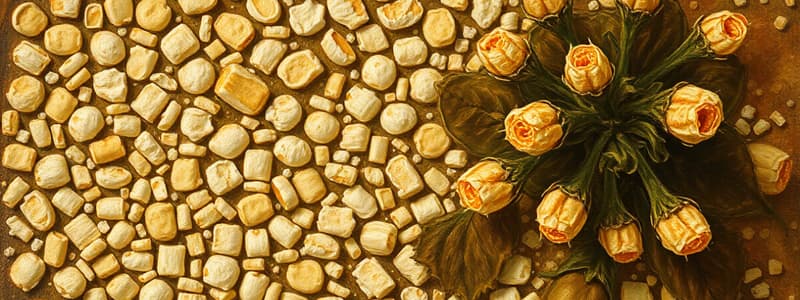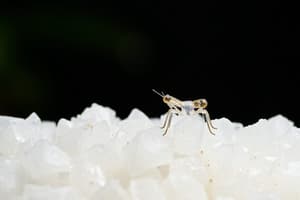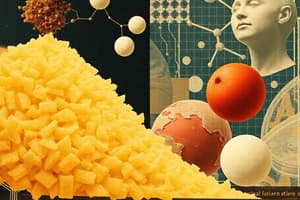Podcast
Questions and Answers
Which enzyme is deficient in von Gierke's disease?
Which enzyme is deficient in von Gierke's disease?
- Brancher enzyme
- Glucose-6-phosphatase (correct)
- Debrancher enzyme
- a-1,4-glucosidase
What clinical feature is associated with Pompe's disease?
What clinical feature is associated with Pompe's disease?
- Hypoglycemia and mental retardation (correct)
- Severe fasting hypoglycemia
- Progressive liver enlargement
- Absence of storage glycogen
What enzyme deficiency characterizes Forbe's disease?
What enzyme deficiency characterizes Forbe's disease?
- Brancher enzyme
- Debrancher enzyme (correct)
- Glucose-6-phosphatase
- C-Peptide
How much does whole blood glucose decrease per hour at room temperature?
How much does whole blood glucose decrease per hour at room temperature?
What is the plasma glucose concentration at which glucagon and other glycemic factors are released?
What is the plasma glucose concentration at which glucagon and other glycemic factors are released?
Which type of symptoms are associated with neurogenic/adrenergic hypoglycemia?
Which type of symptoms are associated with neurogenic/adrenergic hypoglycemia?
What is the fasting requirement for assessing blood glucose levels?
What is the fasting requirement for assessing blood glucose levels?
Which of the following is a characteristic of Andersen's disease?
Which of the following is a characteristic of Andersen's disease?
What is a characteristic symptom of Cushing syndrome?
What is a characteristic symptom of Cushing syndrome?
What condition is characterized by glucose intolerance that begins during pregnancy?
What condition is characterized by glucose intolerance that begins during pregnancy?
Which laboratory finding would you expect in a state of hyperglycemia?
Which laboratory finding would you expect in a state of hyperglycemia?
What is the fasting plasma glucose threshold indicating provisional diabetes diagnosis?
What is the fasting plasma glucose threshold indicating provisional diabetes diagnosis?
What does the HbA1c measurement assess over a period of about 60 days?
What does the HbA1c measurement assess over a period of about 60 days?
Which method separates glycated proteins based on chemical structure?
Which method separates glycated proteins based on chemical structure?
In the Nelson Somogyi method, what is the end product produced indicative of glucose measurement?
In the Nelson Somogyi method, what is the end product produced indicative of glucose measurement?
What is the primary disadvantage of the Glucose Oxidase Method?
What is the primary disadvantage of the Glucose Oxidase Method?
Which reagent is used in the Dubowski method to measure glucose levels in urine and CSF?
Which reagent is used in the Dubowski method to measure glucose levels in urine and CSF?
What does the Hexokinase method quantify to determine glucose concentration?
What does the Hexokinase method quantify to determine glucose concentration?
Which hormone is elevated in pheochromocytoma?
Which hormone is elevated in pheochromocytoma?
Which ketone body comprises the largest percentage in the body?
Which ketone body comprises the largest percentage in the body?
What is indicated by C-peptide levels greater than 1:1 in a patient?
What is indicated by C-peptide levels greater than 1:1 in a patient?
What is the recommended specimen type for ketone measurement in diabetic patients?
What is the recommended specimen type for ketone measurement in diabetic patients?
Which of the following is not a cause of increased ketone levels?
Which of the following is not a cause of increased ketone levels?
What does the Glucose Dehydrogenase Method measure?
What does the Glucose Dehydrogenase Method measure?
What is the recommended situation for measuring ketones in Type 1 Diabetes patients?
What is the recommended situation for measuring ketones in Type 1 Diabetes patients?
Which of the following methods is generally accepted as the reference method for glucose measurement?
Which of the following methods is generally accepted as the reference method for glucose measurement?
What is the general formula for a carbohydrate?
What is the general formula for a carbohydrate?
Which type of carbohydrate has a terminal carbonyl group?
Which type of carbohydrate has a terminal carbonyl group?
Which of the following is a characteristic of reducing sugars?
Which of the following is a characteristic of reducing sugars?
What determines the classification of oligosaccharides?
What determines the classification of oligosaccharides?
Which of the following is an example of a disaccharide?
Which of the following is an example of a disaccharide?
Which carbohydrate classification mainly focuses on whether the compound can exist in non-superimposable forms?
Which carbohydrate classification mainly focuses on whether the compound can exist in non-superimposable forms?
Trioses are classified as carbohydrates with how many carbon atoms?
Trioses are classified as carbohydrates with how many carbon atoms?
Which of the following carbohydrates yield more than 10 monosaccharides upon hydrolysis?
Which of the following carbohydrates yield more than 10 monosaccharides upon hydrolysis?
What characteristic defines non-reducing substances?
What characteristic defines non-reducing substances?
Which enzyme is responsible for converting disaccharides to monosaccharides in the intestine?
Which enzyme is responsible for converting disaccharides to monosaccharides in the intestine?
What is a direct end product of glycolysis?
What is a direct end product of glycolysis?
What type of metabolic pathway is glycolysis classified as?
What type of metabolic pathway is glycolysis classified as?
Which enzyme deficiency is most commonly associated with galactosemia?
Which enzyme deficiency is most commonly associated with galactosemia?
What is a diagnostic indicator of essential fructosuria?
What is a diagnostic indicator of essential fructosuria?
What clinical feature is associated with hereditary fructose intolerance?
What clinical feature is associated with hereditary fructose intolerance?
What condition occurs due to a defect in fructose-1,6-biphosphate?
What condition occurs due to a defect in fructose-1,6-biphosphate?
Flashcards
Carbohydrate general formula
Carbohydrate general formula
Cx(H2O)y, where x and y are integers; CxHyOz.
Monosaccharides
Monosaccharides
Simple sugars that cannot be broken down into simpler sugars.
Disaccharides
Disaccharides
Two monosaccharides joined by a glycosidic linkage.
Reducing sugars
Reducing sugars
Signup and view all the flashcards
Aldose
Aldose
Signup and view all the flashcards
Ketose
Ketose
Signup and view all the flashcards
Glycosidic linkage
Glycosidic linkage
Signup and view all the flashcards
Polysaccharides
Polysaccharides
Signup and view all the flashcards
Non-reducing sugars
Non-reducing sugars
Signup and view all the flashcards
Glycolysis
Glycolysis
Signup and view all the flashcards
Galactosemia
Galactosemia
Signup and view all the flashcards
Essential fructosuria
Essential fructosuria
Signup and view all the flashcards
Hereditary fructose intolerance
Hereditary fructose intolerance
Signup and view all the flashcards
Fructose-1,6-biphosphate deficiency
Fructose-1,6-biphosphate deficiency
Signup and view all the flashcards
Amylase
Amylase
Signup and view all the flashcards
Von Gierke's Disease
Von Gierke's Disease
Signup and view all the flashcards
Pompe's Disease
Pompe's Disease
Signup and view all the flashcards
Forbe's Disease
Forbe's Disease
Signup and view all the flashcards
Andersen's Disease
Andersen's Disease
Signup and view all the flashcards
Hypoglycemia
Hypoglycemia
Signup and view all the flashcards
Neurogenic Hypoglycemia Symptoms
Neurogenic Hypoglycemia Symptoms
Signup and view all the flashcards
Neuroglycopenic Hypoglycemia Symptoms
Neuroglycopenic Hypoglycemia Symptoms
Signup and view all the flashcards
72-hour Fast Test
72-hour Fast Test
Signup and view all the flashcards
Glucose Oxidase Method
Glucose Oxidase Method
Signup and view all the flashcards
Hexokinase Method
Hexokinase Method
Signup and view all the flashcards
Ketone Bodies
Ketone Bodies
Signup and view all the flashcards
Ketonemia
Ketonemia
Signup and view all the flashcards
Ketonuria
Ketonuria
Signup and view all the flashcards
What are some causes of increased ketone levels?
What are some causes of increased ketone levels?
Signup and view all the flashcards
Why are ketone levels measured in Type 1 Diabetes?
Why are ketone levels measured in Type 1 Diabetes?
Signup and view all the flashcards
What specimen is used for Ketone testing?
What specimen is used for Ketone testing?
Signup and view all the flashcards
Cushing syndrome
Cushing syndrome
Signup and view all the flashcards
Pheochromocytoma
Pheochromocytoma
Signup and view all the flashcards
Acromegaly
Acromegaly
Signup and view all the flashcards
Gestational diabetes mellitus (GDM)
Gestational diabetes mellitus (GDM)
Signup and view all the flashcards
Diabetes symptoms
Diabetes symptoms
Signup and view all the flashcards
Fasting plasma glucose (FPG)
Fasting plasma glucose (FPG)
Signup and view all the flashcards
Glycosylated hemoglobin (HbA1c)
Glycosylated hemoglobin (HbA1c)
Signup and view all the flashcards
Microalbuminuria
Microalbuminuria
Signup and view all the flashcards
C-peptide
C-peptide
Signup and view all the flashcards
Folin-Wu method
Folin-Wu method
Signup and view all the flashcards
Study Notes
Carbohydrates
- Carbohydrates are compounds containing C, H, and O.
- General formula: Cx(H₂O)y
- All carbohydrates contain C=O and -OH functional groups.
- Derivatives may have additional chemical groups like phosphates, sulfates, and amines.
- Models include Fischer and Haworth projections.
Classification of Carbohydrates
- Based on the size of the carbon chain:
- Trioses (3 carbons)
- Tetroses (4 carbons)
- Pentoses (5 carbons)
- Hexoses (6 carbons)
- Based on the position of the carbonyl group:
- Aldoses (aldehyde group at the end)
- Ketoses (ketone group in the middle)
- Based on the number of sugar units:
- Monosaccharides (cannot be broken down further)
- Disaccharides (2 monosaccharides joined)
- Oligosaccharides (2-10 monosaccharides joined)
- Polysaccharides (many monosaccharides joined)
- Examples of monosaccharides include glucose, fructose, and galactose.
- Examples of disaccharides include maltose, lactose, and sucrose.
- Examples of polysaccharides include starch and glycogen.
Chemical Properties of Carbohydrates
- Reducing Sugars: Contain a ketone or aldehyde group, with a free anomeric carbon. They can reduce other compounds. Glucose, maltose, fructose, lactose, and galactose are examples.
- Non-Reducing Sugars: Do not have a free anomeric carbon or a ketone or aldehyde group. Sucrose (table sugar) is an example.
Major Metabolic Pathways
- Glycogenesis: Conversion of glucose to glycogen for storage.
- Glycogenolysis: Breakdown of glycogen to glucose.
- Hexose Monophosphate Shunt (HMP): Converts glucose-6-phosphate, creating NADPH and pentose phosphates.
Diabetes Mellitus
- A group of metabolic diseases characterized by hyperglycemia (high blood sugar).
- Glucosuria occurs when plasma glucose exceeds 180 mg/dL.
- Ketosis develops with excessive Acetyl-CoA synthesis.
- Hyperglycemia results from hormone imbalances.
Types of Diabetes
- Type 1 Diabetes (possibly autoimmune and insulin dependent)
- Type 2 Diabetes (possibly insulin resistant)
- Gestational Diabetes Mellitus (GDM)(occurs during pregnancy)
Criteria and Points of Difference
- Detailed information about the types of diabetes based on various medical criteria.
Specimen Collection and Handling
- Fasting plasma glucose is typically higher in the morning.
- Normal fasting glucose for serum/plasma is 70-110 mg/dL.
- Arterial/capillary glucose is about 5 mg/dL higher than venous glucose when fasting.
- Urine glucose analysis needs preservative and 4°C storage to prevent loss.
- CSF glucose analysis requires centrifugation, 4°C-20°C storage if delayed, and normal CSF glucose is roughly 60-70% of plasma glucose.
- The renal threshold for glucose is 180 mg/dL
Glucose Metabolism
- Various tests for diagnosing, and long-term control of glucose metabolism are discussed in detail. (Includes various methods of testing blood glucose, and HbA1c)
Studying That Suits You
Use AI to generate personalized quizzes and flashcards to suit your learning preferences.




